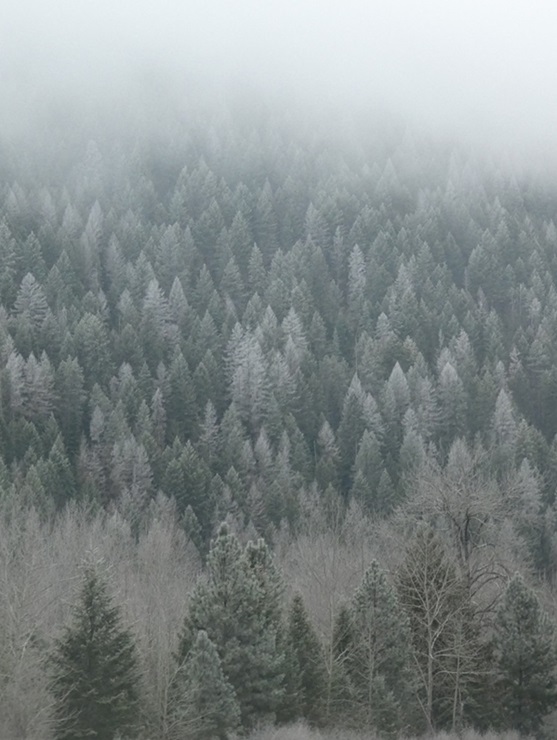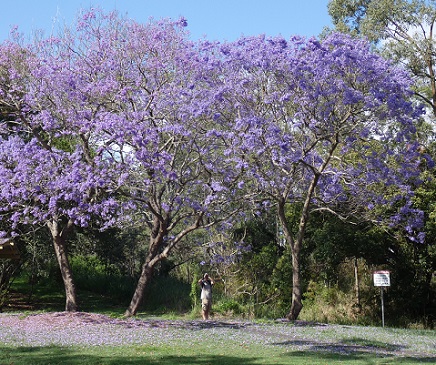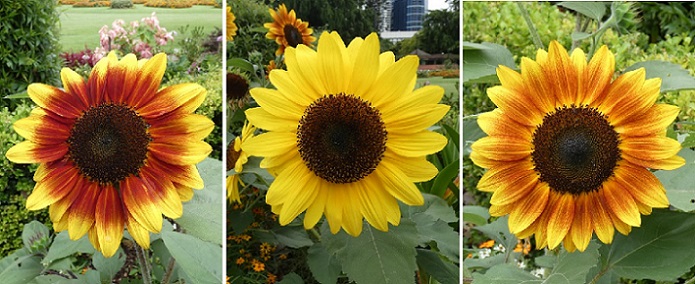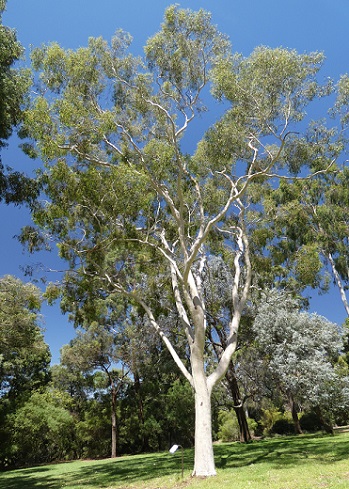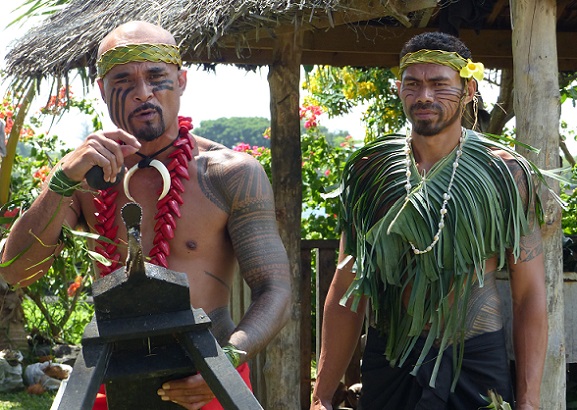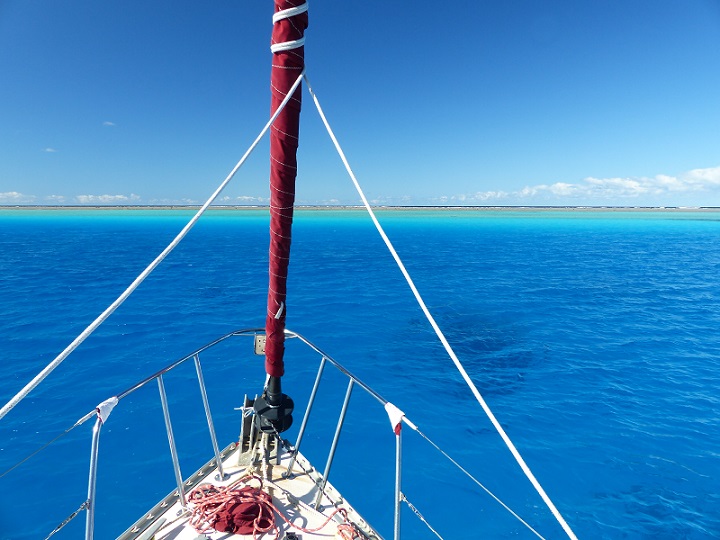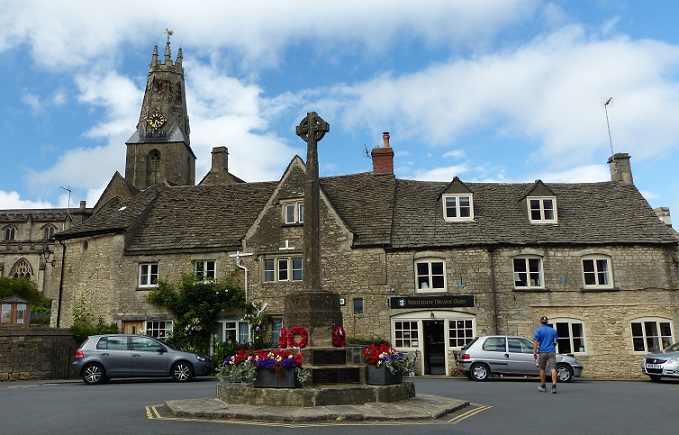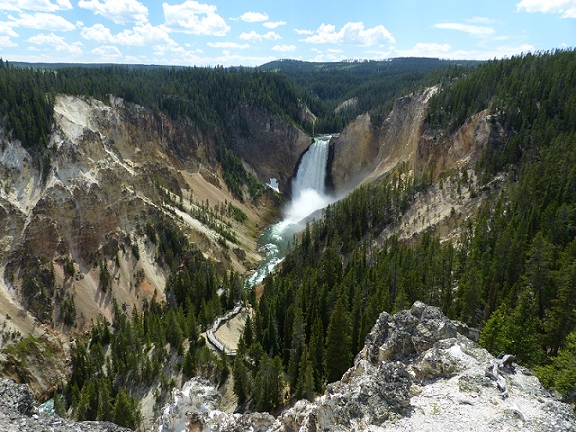
Tregoning
12 April 2024 | We are back aboard Tregoning in Mersin Marina, Mersin, Türkiye
02 April 2024 | We are in Toronto Airport, Canada: Tregoning is in Mersin Marina, Mersin, Türkiye
25 February 2024 | We are back in Gainesville, FL: Tregoning is in Mersin Marina, Mersin, Türkiye
18 February 2024 | We are in Glenwood, New Mexico: Tregoning is in Mersin Marina, Mersin, Türkiye
12 February 2024 | We are in Morro Bay, California: Tregoning is in Mersin Marina, Mersin, Türkiye
19 January 2024 | We are in Vancouver, BC Canada: Tregoning is in Mersin Marina, Mersin, Türkiye
01 January 2024 | We are in Washington State: Tregoning is in Mersin Marina, Mersin, Türkiye
15 December 2023 | We are in Minnesota: Tregoning is in Mersin Marina, Mersin, Türkiye
18 November 2023 | We are in Florida: Tregoning is in Mersin Marina, Mersin, Türkiye
29 October 2023 | We're in Florida - Tregoning is at B-dock, Mersin Marina, Mersin, Türkiye
21 October 2023 | 7 Oda Kapadokya Cave Hotel, Ürgüp, Türkiye
14 October 2023 | Hotel Aşikoğlu, Boğazkale, Türkiye
07 October 2023 | B-dock, Mersin Marina, Mersin, Türkiye
19 September 2023 | “Chez Jon & Angela”, Near Otterton, Devon, UK
14 September 2023 | Airbnb in Fortuneswell on the Isle of Portland, Dorset, UK
11 September 2023 | With Mike, Grange-over-Sands, Cumbria, UK
03 September 2023 | Ardington House, Ardington, Oxfordshire, UK
24 August 2023 | Near "Chez Joan and Peter", College of Roseisle, Moray, Scotland
11 August 2023 | Andrew's house (not exactly), Lichfield, UK
22 July 2023 | Chez Gail, near the New York Café, Budapest, Hungary
Finding tapa but not the nature reserve
12 July 2017 | Anchorage off Big Mama’s Yacht Club, Pangaimotu, near Tongatapu, Tonga
Photo: Village women unroll a long sheet of tapa to be dried in the sun after being dyed
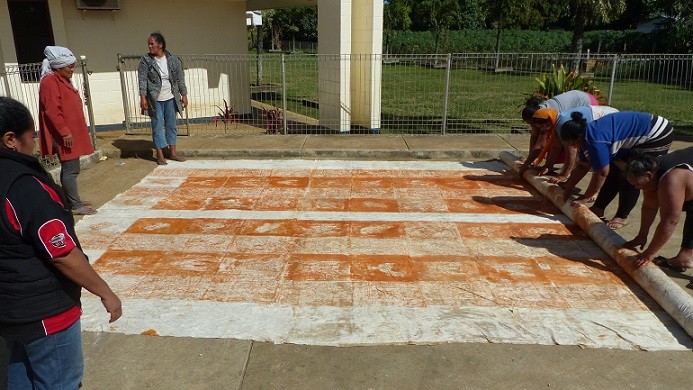
As anticipated, we decided to rent a car again (a mere T$40 plus T$25 fuel between the four of us) on Tuesday (11th July) with the goal of walking in the nature reserve that was rumored to be at the northeast corner of Tongatapu. Our fortunes on this trip were more mixed that previously, starting with getting to the Outrigger Brewery when it was open only to find that they were out of stock until the weekend. For Marisa and Bavo this was greeted with an expression in Flemish that I am sure was similar to "Bother!"
On the plus side, we were able to pick-up Randall's passport from the Immigration Office with his visa extension until mid-September. On the day that he had applied for the extension, we were told to sit and wait after receiving a receipt for his payment and passport. It was only after about three hours (including lunchtime) that someone asked what we were waiting for and revealed that it might be several days before the extended visa was ready. OK...
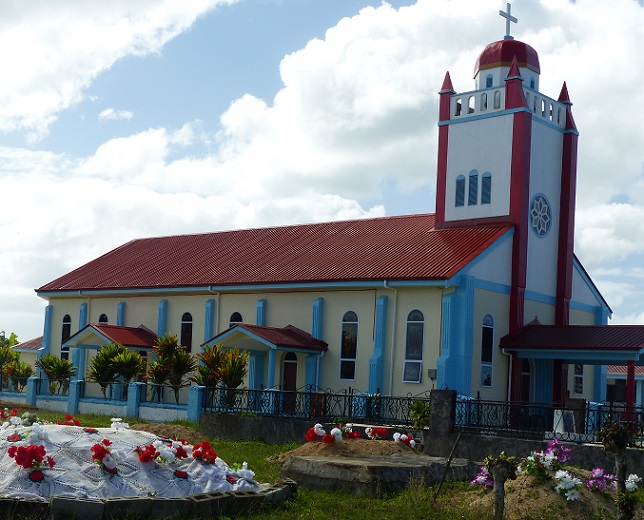
A church in the village of Fohala by the lagoon
Marisa was keen to see something of the Fanga'uta and Fangakakau Lagoons, which were designated by the government as nature reserves in 1974. We drove to the south side and explored the bit of land between the two lagoons. We passed some interesting churches, plenty of pigs, and ended-up on the east side at the Kauvai Royal Residence. As we drove into the open gate on a rather poorly maintained road, a van coming the other way stopped to greet us. I was relieved that the elderly driver did not look like a trigger-happy royal guard and he, in fact, welcomed us to continue and visit the former royal residence. It had not been lived in for several years after being passed on to a royal grandson.
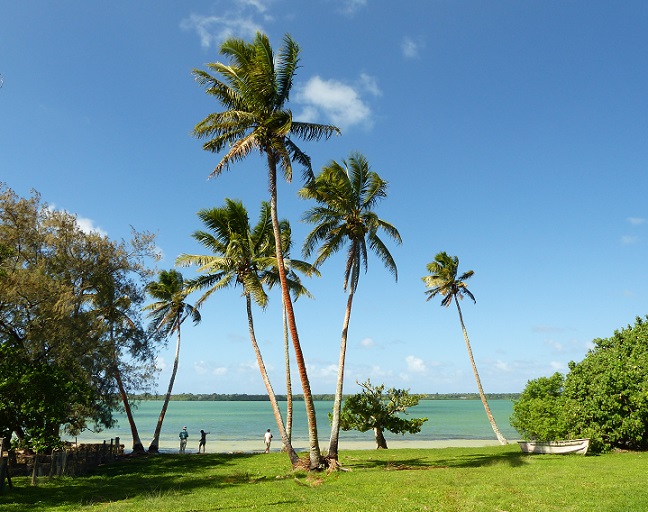
Looking over the eastern side of the lagoon near the former royal residence
People were probably living in the adjacent house and cabin but the fairly modest royal residence had obviously seen better days. Marsia boldly walked in the gate that opened onto the lagoon shore, and after peering in the windows, found an open door so we all peeked inside. There was some furniture and cabinets of glassware but the rather garish linoleum on the floor was curling-up and the place had definitely not seen a royal resident in many years.
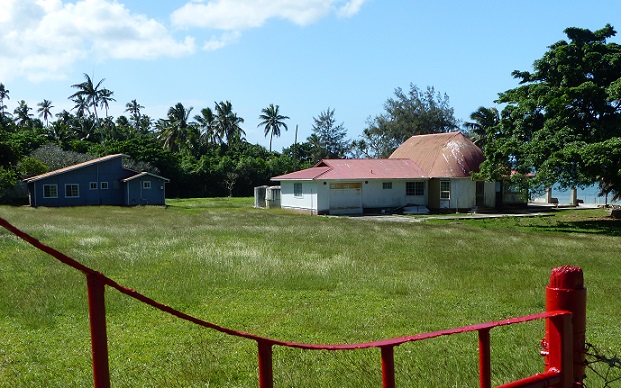
With the signature royal red roof and rounded-end, Tongan fale shape, the Kauvai former royal residence
As we drove back towards the southeast part of Tongatapu, we were passing through a village when we noticed several women walking along the street in a line, obviously carrying something long and heavy. We paused to ask them what they were doing, since the item looked more like a rolled-up carpet than a body, and once told it was a large tapa cloth, we stopped to admire their handiwork. This was a massive piece of tapa which they unrolled on a flat concrete area alongside the road, which had looked like a bus-stop or parking area but was probably built specifically for this purpose.
The ladies unrolled the cloth and most of them left it to dry while one cheerful soul patiently answered all of our questions. From her we learned that it had taken several women of the village about a week to prepare this huge cloth, which Randall paced-off as being about 5 m by 30 m (16 by 100 feet). It was being dried because they had just applied the orange/brown dye to create pictures of a lion (symbol of royalty), the Tongan shield, an eagle, and a palm tree. Once the fabric was dry, they would apply caustic soda to create black lines and patterns. The women of the village produced a tapa (not necessarily all this big) about once a week for different families. The families would use their tapa as part of a dowry, as part of various life-event celebrations, as ceremonial gifts, or for sale.
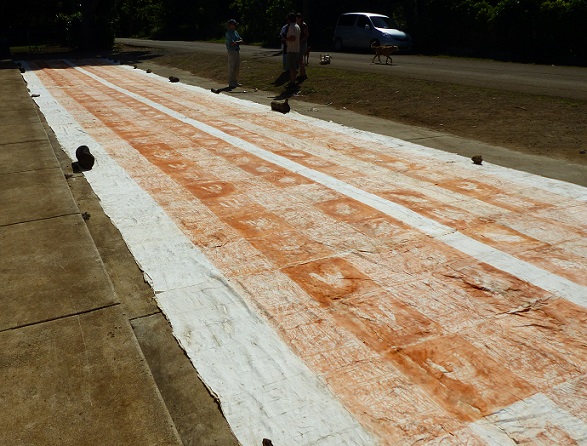
The full length of the tapa (with Randall and Bavo beyond)
We have seen tapa products all over Polynesia, from bookmarks and greeting cards to items of traditional clothing to huge backdrops for public events. It is a fabric produced from the inner layer of the bark of the paper mulberry tree (Broussonetia papyrifera or hiapo in Tongan), which is often grown along the edges of plantations. After being stripped from the tree, the outer bark is discarded and the inner layer is dried in the sun then soaked in water before being beaten into a thin, papery layer. The beating on a wooden anvil (tutua) is typically done by women using wooden mallets (ike) which have faces with coarse grooves, fine grooves, and a smooth flat side. The tapa is beaten with the coarse grooves first then progressively finer grooves until the flat side us used. The "thonk" sound of the ike on the tutua is heard everyday (except Sundays) all over Tonga and to the uninitiated gives the impression of continuous building projects.
Thin strips of the flattened bark are beaten together to form wider and longer sheets, with manioke (manioc) starch used as glue if necessary. The decorations are added by creating stencils from sticks or coconut husks, which have the lines of the motif as ridges on the side of a wooden drum. The brown dye is rubbed onto the tapa as it is draped over the stencil-drum, with the darkest lines where the dye is rubbed hard onto the protruding ridges of the stencil. The dye comes from the soaked bark of either koka tree (bishopwood - Bischofia javanica) or red mangrove (Rhizophora mangle) and our host's hands were well-stained with it.
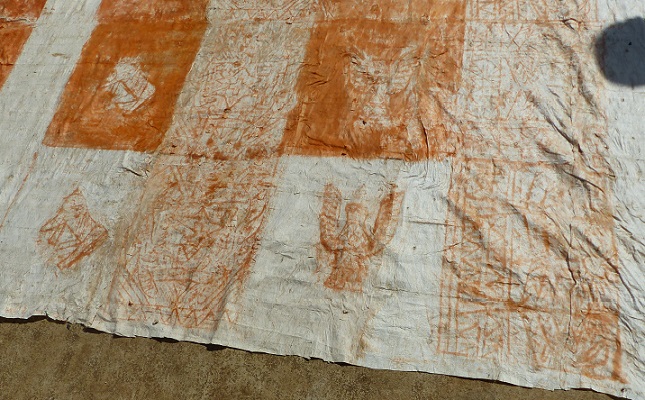
Motifs on the tapa (L to R): Lion, Tongan shield, eagle, and palm tree
Our stop to see the tapa being unrolled was a completely random event but, as far as I was concerned, it was the highlight of the day. We then drove on to the 'Oholei Beach Resort, where someone had recommended that we eat lunch and visit the Hina Cave. Lunch was not being served and the cave was only accessible during the resort's Tongan feast buffet and floorshow on Wednesday and Friday evenings (buffet lunch only on Sunday). This was disappointing but we had enough snacks to share and keep us going until dinnertime, when we treated ourselves to dinner at the Little Italy restaurant in Nuku'alofa.
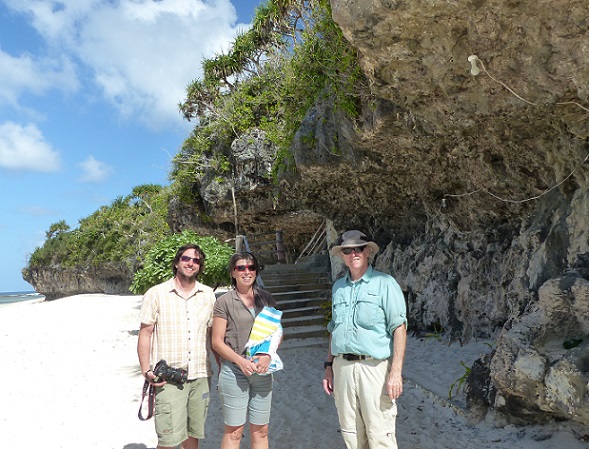
Smiling but hungry, Bavo, Marisa, and Randall by the undercut rocks on 'Oholei Beach
The stop at 'Oholei Beach was not completely wasted because it gave us a chance to see a modern Tongan roof being put on a fale (wooden cabin) down by the beach. Sheets of plastic had been lain over the roof frame (which probably had a wooden/woven ceiling inside) and these were covered with plastic netting. The whole thing was sealed with bucket-loads of cement that were spread over the plastic and netting in a thin layer. The cement was mixed on the ground and a bucket-brigade of workers tossed the full buckets up to each other with an ease, rhythm, spiraling motion, and overall skill that was really quite impressive. Goodness knows how long this type of roof lasts but a quick dab of cement and a leak is fixed.
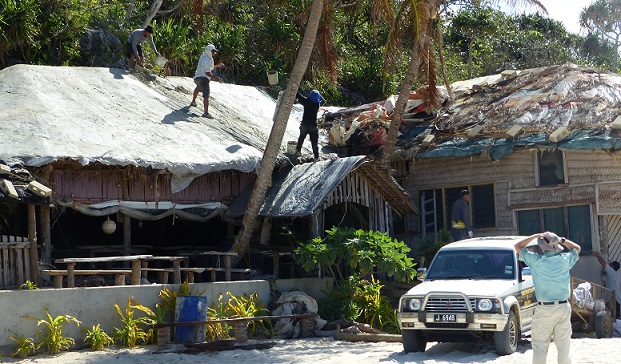
Randall watches buckets of cement being thrown up to the top of the new roof
As for our search for the nature reserve at the northeastern Mu'i Hopohoponga Point, well, that was not very illuminating. Nobody we had asked about it (including at the Visitors Center) had any idea what we were talking about and the only reference we had was from a 2009 Lonely Planet guide of Tonga of Marisa's. The description sounded just like the sort of place we would want to visit:
"Muihopohoponga Reserve was set up in an effort to protect several species of native trees and some of the natural bush land that once covered the entire island. It incorporates a 2 km stretch of white sand beach at the easternmost extreme of Tongatapu and can be reached by a 2 km walking track leading southeast from Niutoua."
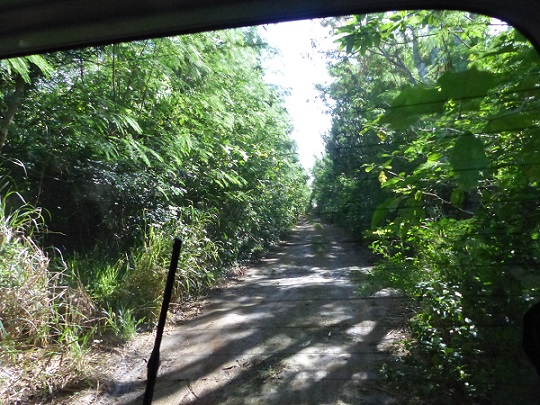
Looking back at the narrow dirt road down which we were searching for the nature reserve
We had noticed that some brown Ministry of Tourism road signs had been added to sites such as the terraced tombs and trilithon since our last road-trip, presumably in preparation for the influx of whale-seeking tourists. But there was no sign at the end of the road in Niutoua Village so we just followed dirt tracks heading in a vaguely south and east direction. The roads became progressively narrower with more vegetation along the middle as we crept further and further through small plantations of bananas, coconuts, and taro. The stubble had been burned on a few plots and this island-wide practice probably explained the haze of smoke that would drift towards our anchorage on relatively calm days. That and people burning their trash and yard-waste.
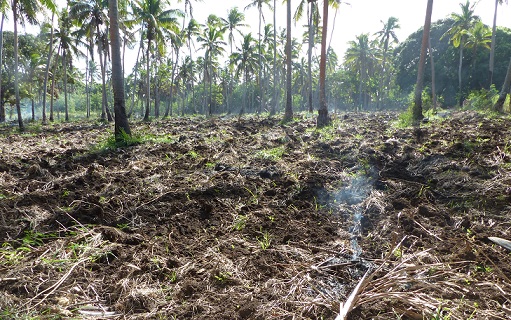
Stubble of an understory crop that has been burned in a coconut plantation
We were surprised to find a few pine trees and breadfruit trees alongside the road, presumably left-over from former house sites, but there was no sign of any undisturbed forest. We met one man on a bicycle who asked us with great surprise "What are you doing here?" When we mentioned the nature reserve, he just gestured ahead and said we should (or was it "could"?) keep going. While the optimists among us hoped that was a positive indication that we were nearly there, even they eventually had to admit that it was necessary to turn around and assume that the man had simply been trying to "save face" (important in Tongan culture) or had no idea what we had said.

At the end of the road at Mu'i Hopohoponga Point
A final turn and we bounced down another road going in a more easterly direction and which eventually brought us to the shoreline at Mu'i Hopohoponga Point. There was a tiny beach with a fringing reef and a navigation tower. Climbing the tower, Marisa, Bavo, and I had good views of waves and small blowholes at the reef's edge. Sharply undercut rock ran north and south along the coastline reminding Randall and me of the similar formations we had seen around the islands in the Vava'u Group in 2015.
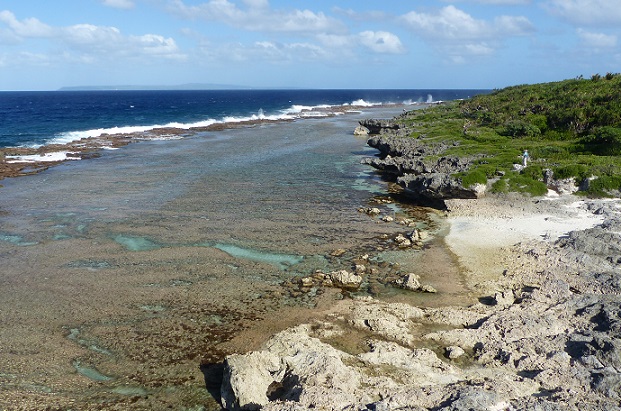
Fringing reef with distant blowholes, sharply undercut rock at the shoreline, and a somewhat less-than-2-km-long sand beach seen by looking south from the navigation tower at Mu'i Hopohoponga Point
Maybe we ended up driving along the 2 km walk that the guidebook had mentioned and most of the sandy beach was gone; maybe we were not in the correct spot and the long beach was further south of us; maybe the guidebook entry was written based on somebody's story without being properly checked; or maybe the reserve and beach have gradually disappeared in the last eight years. This is the type of situation where local knowledge should help but having not met anyone who knew what we were talking about, the mysterious nature reserve will at least stay protected from us.
On the plus side, we were able to pick-up Randall's passport from the Immigration Office with his visa extension until mid-September. On the day that he had applied for the extension, we were told to sit and wait after receiving a receipt for his payment and passport. It was only after about three hours (including lunchtime) that someone asked what we were waiting for and revealed that it might be several days before the extended visa was ready. OK...

A church in the village of Fohala by the lagoon
Marisa was keen to see something of the Fanga'uta and Fangakakau Lagoons, which were designated by the government as nature reserves in 1974. We drove to the south side and explored the bit of land between the two lagoons. We passed some interesting churches, plenty of pigs, and ended-up on the east side at the Kauvai Royal Residence. As we drove into the open gate on a rather poorly maintained road, a van coming the other way stopped to greet us. I was relieved that the elderly driver did not look like a trigger-happy royal guard and he, in fact, welcomed us to continue and visit the former royal residence. It had not been lived in for several years after being passed on to a royal grandson.

Looking over the eastern side of the lagoon near the former royal residence
People were probably living in the adjacent house and cabin but the fairly modest royal residence had obviously seen better days. Marsia boldly walked in the gate that opened onto the lagoon shore, and after peering in the windows, found an open door so we all peeked inside. There was some furniture and cabinets of glassware but the rather garish linoleum on the floor was curling-up and the place had definitely not seen a royal resident in many years.

With the signature royal red roof and rounded-end, Tongan fale shape, the Kauvai former royal residence
As we drove back towards the southeast part of Tongatapu, we were passing through a village when we noticed several women walking along the street in a line, obviously carrying something long and heavy. We paused to ask them what they were doing, since the item looked more like a rolled-up carpet than a body, and once told it was a large tapa cloth, we stopped to admire their handiwork. This was a massive piece of tapa which they unrolled on a flat concrete area alongside the road, which had looked like a bus-stop or parking area but was probably built specifically for this purpose.
The ladies unrolled the cloth and most of them left it to dry while one cheerful soul patiently answered all of our questions. From her we learned that it had taken several women of the village about a week to prepare this huge cloth, which Randall paced-off as being about 5 m by 30 m (16 by 100 feet). It was being dried because they had just applied the orange/brown dye to create pictures of a lion (symbol of royalty), the Tongan shield, an eagle, and a palm tree. Once the fabric was dry, they would apply caustic soda to create black lines and patterns. The women of the village produced a tapa (not necessarily all this big) about once a week for different families. The families would use their tapa as part of a dowry, as part of various life-event celebrations, as ceremonial gifts, or for sale.

The full length of the tapa (with Randall and Bavo beyond)
We have seen tapa products all over Polynesia, from bookmarks and greeting cards to items of traditional clothing to huge backdrops for public events. It is a fabric produced from the inner layer of the bark of the paper mulberry tree (Broussonetia papyrifera or hiapo in Tongan), which is often grown along the edges of plantations. After being stripped from the tree, the outer bark is discarded and the inner layer is dried in the sun then soaked in water before being beaten into a thin, papery layer. The beating on a wooden anvil (tutua) is typically done by women using wooden mallets (ike) which have faces with coarse grooves, fine grooves, and a smooth flat side. The tapa is beaten with the coarse grooves first then progressively finer grooves until the flat side us used. The "thonk" sound of the ike on the tutua is heard everyday (except Sundays) all over Tonga and to the uninitiated gives the impression of continuous building projects.
Thin strips of the flattened bark are beaten together to form wider and longer sheets, with manioke (manioc) starch used as glue if necessary. The decorations are added by creating stencils from sticks or coconut husks, which have the lines of the motif as ridges on the side of a wooden drum. The brown dye is rubbed onto the tapa as it is draped over the stencil-drum, with the darkest lines where the dye is rubbed hard onto the protruding ridges of the stencil. The dye comes from the soaked bark of either koka tree (bishopwood - Bischofia javanica) or red mangrove (Rhizophora mangle) and our host's hands were well-stained with it.

Motifs on the tapa (L to R): Lion, Tongan shield, eagle, and palm tree
Our stop to see the tapa being unrolled was a completely random event but, as far as I was concerned, it was the highlight of the day. We then drove on to the 'Oholei Beach Resort, where someone had recommended that we eat lunch and visit the Hina Cave. Lunch was not being served and the cave was only accessible during the resort's Tongan feast buffet and floorshow on Wednesday and Friday evenings (buffet lunch only on Sunday). This was disappointing but we had enough snacks to share and keep us going until dinnertime, when we treated ourselves to dinner at the Little Italy restaurant in Nuku'alofa.

Smiling but hungry, Bavo, Marisa, and Randall by the undercut rocks on 'Oholei Beach
The stop at 'Oholei Beach was not completely wasted because it gave us a chance to see a modern Tongan roof being put on a fale (wooden cabin) down by the beach. Sheets of plastic had been lain over the roof frame (which probably had a wooden/woven ceiling inside) and these were covered with plastic netting. The whole thing was sealed with bucket-loads of cement that were spread over the plastic and netting in a thin layer. The cement was mixed on the ground and a bucket-brigade of workers tossed the full buckets up to each other with an ease, rhythm, spiraling motion, and overall skill that was really quite impressive. Goodness knows how long this type of roof lasts but a quick dab of cement and a leak is fixed.

Randall watches buckets of cement being thrown up to the top of the new roof
As for our search for the nature reserve at the northeastern Mu'i Hopohoponga Point, well, that was not very illuminating. Nobody we had asked about it (including at the Visitors Center) had any idea what we were talking about and the only reference we had was from a 2009 Lonely Planet guide of Tonga of Marisa's. The description sounded just like the sort of place we would want to visit:
"Muihopohoponga Reserve was set up in an effort to protect several species of native trees and some of the natural bush land that once covered the entire island. It incorporates a 2 km stretch of white sand beach at the easternmost extreme of Tongatapu and can be reached by a 2 km walking track leading southeast from Niutoua."

Looking back at the narrow dirt road down which we were searching for the nature reserve
We had noticed that some brown Ministry of Tourism road signs had been added to sites such as the terraced tombs and trilithon since our last road-trip, presumably in preparation for the influx of whale-seeking tourists. But there was no sign at the end of the road in Niutoua Village so we just followed dirt tracks heading in a vaguely south and east direction. The roads became progressively narrower with more vegetation along the middle as we crept further and further through small plantations of bananas, coconuts, and taro. The stubble had been burned on a few plots and this island-wide practice probably explained the haze of smoke that would drift towards our anchorage on relatively calm days. That and people burning their trash and yard-waste.

Stubble of an understory crop that has been burned in a coconut plantation
We were surprised to find a few pine trees and breadfruit trees alongside the road, presumably left-over from former house sites, but there was no sign of any undisturbed forest. We met one man on a bicycle who asked us with great surprise "What are you doing here?" When we mentioned the nature reserve, he just gestured ahead and said we should (or was it "could"?) keep going. While the optimists among us hoped that was a positive indication that we were nearly there, even they eventually had to admit that it was necessary to turn around and assume that the man had simply been trying to "save face" (important in Tongan culture) or had no idea what we had said.

At the end of the road at Mu'i Hopohoponga Point
A final turn and we bounced down another road going in a more easterly direction and which eventually brought us to the shoreline at Mu'i Hopohoponga Point. There was a tiny beach with a fringing reef and a navigation tower. Climbing the tower, Marisa, Bavo, and I had good views of waves and small blowholes at the reef's edge. Sharply undercut rock ran north and south along the coastline reminding Randall and me of the similar formations we had seen around the islands in the Vava'u Group in 2015.

Fringing reef with distant blowholes, sharply undercut rock at the shoreline, and a somewhat less-than-2-km-long sand beach seen by looking south from the navigation tower at Mu'i Hopohoponga Point
Maybe we ended up driving along the 2 km walk that the guidebook had mentioned and most of the sandy beach was gone; maybe we were not in the correct spot and the long beach was further south of us; maybe the guidebook entry was written based on somebody's story without being properly checked; or maybe the reserve and beach have gradually disappeared in the last eight years. This is the type of situation where local knowledge should help but having not met anyone who knew what we were talking about, the mysterious nature reserve will at least stay protected from us.
Comments
| Vessel Name: | Tregoning |
| Vessel Make/Model: | Morgan Classic 41 |
| Hailing Port: | Gainesville, FL |
| Crew: | Alison and Randall |
| About: | We cast-off from Fernandina Beach in north Florida on 1st June 2008 and we have been cruising on Tregoning ever since. Before buying Tregoning, both of us had been sailing on smaller boats for many years and had worked around boats and water throughout our careers. |
| Extra: | “Tregoning” (rhymes with “belonging”) and is a Cornish word (meaning “homestead of Cohnan” or “farm by the ash trees”) and was Alison's mother’s middle name. Cornwall is in southwest England and is where Alison grew-up. |
Tregoning's Photos - Main
 |
Extra photographs from our three-week campervan tour of the South Island from November 15th to December 5th 2015
217 Photos
Created 4 January 2016
|
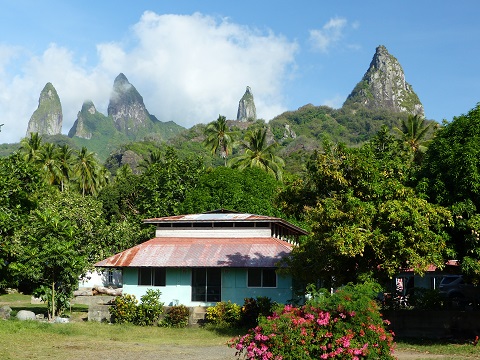 |
Random pictures from our month spent on the islands of Hiva Oa, Tahuata, Ua Pou, and Nuku Hiva
45 Photos
Created 18 July 2015
|
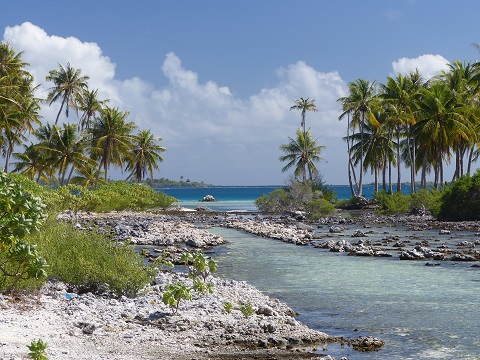 |
Random pictures from our month spent in 4 Tuamotu Atolls; Ahe, Fakarava, Tahanea, and Toau
32 Photos
Created 1 July 2015
|
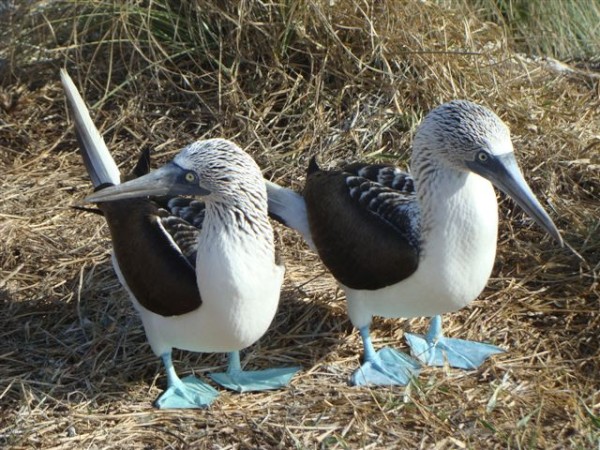 |
Some of the birds, fish, reptiles, and mammals (and others) that we have seen in Mexico
74 Photos
Created 5 May 2014
|
Tregoning

Who: Alison and Randall
Port: Gainesville, FL
